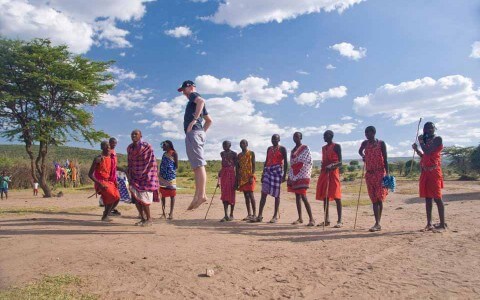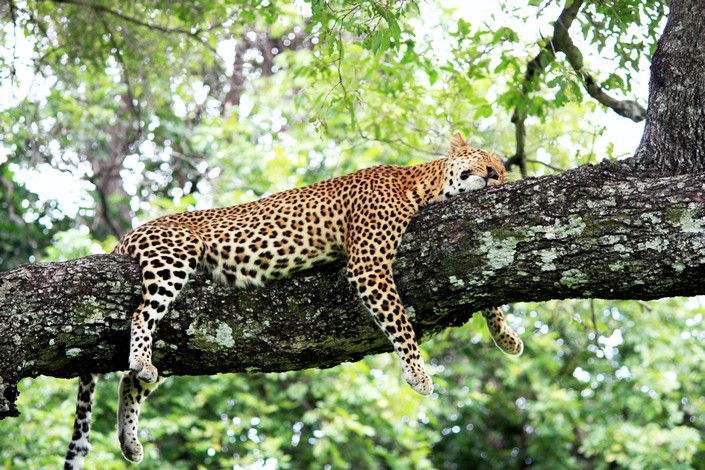Tanzania’s Ngorongoro Crater is the largest unflooded and unbroken crater in the world, the site of a massive once-active volcano that last erupted millions of years ago. Covering a massive area of three hundred square kilometres, the crater is home to some of the densest population of wildlife (particularly lions and other predators) found anywhere on the planet.
As a volcanic caldera, the Ngorongoro Crater, its high walls contain an entire microcosmic ecosystem, complete with lakes, forests, and plains. Herein live hundreds of species of wildlife. The crater is a breathtaking visual spectacle, making it a photographer’s paradise. There’s not much to beat the view that greets you when you stand on the rim of the crater looking down into the lush emerald-green caldera, topped by a deep blue cloud-studded sky.
The same sentiment is shared about the abundant wildlife roaming on the crater floor. On game drives you’ll feel like you’re inside a Discovery Channel nature documentary: plains are filled with lions, elephants, giraffe, black rhino, wildebeest, all against a spectacular backdrop of the 600-metre high crater wall. It’s not uncommon for people to see all of the Big Five in just one day!
How to do a Ngorongoro Crater safari on a budget
The Ngorongoro Crater is an expensive safari destination, with pricey park entrance fees and most lodges catering for the high end market. If you want to travel to the park on a budget, you need to do a self-drive trip or a budget overland safari (although there’s no way around those high entrance fees).
If you’re going to self-drive (flying into Arusha and renting a car there), it’s a complicated to pay entrance fees for the park. Be prepared for the hassle! You have to know exactly how long you will spend in the park, and then pay the fees at a Tanzanian bank before you get to the park gates.
In terms of accommodation, the most popular camp inside the crater is Simba, where there are ablution blocks with hot water showers. If you don’t want to camp, Rhino Lodge on the edge of the crater is a mid-range lodge with comfortable rooms (although at $120 per person, it’s not exactly cheap). Just over 50km away from the crater is the small town of Karatu, where there are more budget accommodation options and you’ll spend a lot less on a room than on the crater rim.
A better option in terms of ease and affordablity is go on a budget Ngorongoro Crater safari on an overland truck, where your meals, accommodation and park entrance fees are included.
We have the best Ngorongoro Crater budget safaris on offer:
From From From From From From From From From From From From From From From From From From From From From From From From From From From From From From From From From From From From From From From From From From From From From From From From From From From From From From From From From From From From From From From From From From From From From From From From From From From From From
Tour Length
41 days
Group Size
Max 16
Starts & Ends
Starts: Cape Town Ends: Nairobi
Countries
South Africa, Namibia, Botswana, Zambia, Malawi, Tanzania, Kenya
Overview
This Cape Town to Kenya Overland Epic Adventure provides a broad insight into Southern and Eastern Africa’s grandest attractions.
We leave from Cape Town and head off to Mt Kilimanjaro, explore the gigantic sand dunes in ancient deserts and relax on golden beaches on the tropical island of Zanzibar. The mighty Victoria Falls is next on the list before journeying to the Chobe River, viewing the majestic Ngorongoro Crater and the infinite Serengeti plains.
Cape Town to Kenya Epic Tour (41 Days)
Tour start → end dates
Price
Enquire
11 May 2024
→
20 Jun 2024
Check Availability
08 Jun 2024
→
18 Jul 2024
Check Availability
22 Jun 2024
→
01 Aug 2024
Check Availability
06 Jul 2024
→
15 Aug 2024
Check Availability
17 Aug 2024
→
26 Sep 2024
Check Availability
31 Aug 2024
→
10 Oct 2024
Check Availability
14 Sep 2024
→
24 Oct 2024
Check Availability
28 Sep 2024
→
07 Nov 2024
Check Availability
12 Oct 2024
→
21 Nov 2024
Check Availability
26 Oct 2024
→
05 Dec 2024
Check Availability
09 Nov 2024
→
19 Dec 2024
Check Availability
23 Nov 2024
→
02 Jan 2025
Check Availability
07 Dec 2024
→
16 Jan 2025
Check Availability
21 Dec 2024
→
30 Jan 2025
Check Availability
04 Jan 2025
→
13 Feb 2025
Check Availability
18 Jan 2025
→
27 Feb 2025
Check Availability
01 Feb 2025
→
13 Mar 2025
Check Availability
15 Feb 2025
→
27 Mar 2025
Check Availability
01 Mar 2025
→
10 Apr 2025
Check Availability
15 Mar 2025
→
24 Apr 2025
Check Availability
29 Mar 2025
→
08 May 2025
Check Availability
12 Apr 2025
→
22 May 2025
Check Availability
26 Apr 2025
→
05 Jun 2025
Check Availability
10 May 2025
→
19 Jun 2025
Check Availability
24 May 2025
→
03 Jul 2025
Check Availability
07 Jun 2025
→
17 Jul 2025
Check Availability
21 Jun 2025
→
31 Jul 2025
Check Availability
05 Jul 2025
→
14 Aug 2025
Check Availability
19 Jul 2025
→
28 Aug 2025
Check Availability
02 Aug 2025
→
11 Sep 2025
Check Availability
16 Aug 2025
→
25 Sep 2025
Check Availability
30 Aug 2025
→
09 Oct 2025
Check Availability
13 Sep 2025
→
23 Oct 2025
Check Availability
27 Sep 2025
→
06 Nov 2025
Check Availability
11 Oct 2025
→
20 Nov 2025
Check Availability
25 Oct 2025
→
04 Dec 2025
Check Availability
08 Nov 2025
→
18 Dec 2025
Check Availability
22 Nov 2025
→
01 Jan 2026
Check Availability
06 Dec 2025
→
15 Jan 2026
Check Availability
20 Dec 2025
→
29 Jan 2026
Check Availability
Tour Length
13 days
Group Size
Max 16
Starts & Ends
Starts: Nairobi Ends: Dar es Salaam
Countries
Kenya,
Tanzania
Overview
With showpiece attractions by the likes of the Serengeti, Ngorongoro Crater, and Mount Kilimanjaro, East Africa is story-book Africa. This whirlwind adventure sees you living out your wildest dreams with open-top game drives through vast plains and eye-opening Masaai village tours. After getting your fill of wildlife and local living, dust off your boots and soak up the African sun on the powdery-white beaches of Zanzibar. Now this is a dream come true.
13 Day East Africa Game Parks and Zanzibar Safari
Tour start → end dates
Price
Enquire
02 Jun 2024
→
14 Jun 2024
Check Availability
11 Aug 2024
→
23 Aug 2024
Check Availability
08 Sep 2024
→
20 Sep 2024
Check Availability
22 Sep 2024
→
04 Oct 2024
Check Availability
06 Oct 2024
→
18 Oct 2024
Check Availability
20 Oct 2024
→
01 Nov 2024
Check Availability
03 Nov 2024
→
15 Nov 2024
Check Availability
17 Nov 2024
→
29 Nov 2024
Check Availability
01 Dec 2024
→
13 Dec 2024
Check Availability
15 Dec 2024
→
27 Dec 2024
Check Availability
29 Dec 2024
→
10 Jan 2025
Check Availability
12 Jan 2025
→
24 Jan 2025
Check Availability
26 Jan 2025
→
07 Feb 2025
Check Availability
09 Feb 2025
→
21 Feb 2025
Check Availability
23 Feb 2025
→
07 Mar 2025
Check Availability
09 Mar 2025
→
21 Mar 2025
Check Availability
23 Mar 2025
→
04 Apr 2025
Check Availability
06 Apr 2025
→
18 Apr 2025
Check Availability
20 Apr 2025
→
02 May 2025
Check Availability
04 May 2025
→
16 May 2025
Check Availability
18 May 2025
→
30 May 2025
Check Availability
01 Jun 2025
→
13 Jun 2025
Check Availability
15 Jun 2025
→
27 Jun 2025
Check Availability
29 Jun 2025
→
11 Jul 2025
Check Availability
13 Jul 2025
→
25 Jul 2025
Check Availability
27 Jul 2025
→
08 Aug 2025
Check Availability
10 Aug 2025
→
22 Aug 2025
Check Availability
24 Aug 2025
→
05 Sep 2025
Check Availability
07 Sep 2025
→
19 Sep 2025
Check Availability
21 Sep 2025
→
03 Oct 2025
Check Availability
05 Oct 2025
→
17 Oct 2025
Check Availability
19 Oct 2025
→
31 Oct 2025
Check Availability
02 Nov 2025
→
14 Nov 2025
Check Availability
16 Nov 2025
→
28 Nov 2025
Check Availability
30 Nov 2025
→
12 Dec 2025
Check Availability
14 Dec 2025
→
26 Dec 2025
Check Availability
28 Dec 2025
→
09 Jan 2026
Check Availability
What to do on a Ngorongoro Crater safari
Other than game viewing, there are no activities on offer inside the crater itself. Outside the crater there are traditional Maasai villages to visit, trekking options and the Olduvai Gorge to explore.
When to do a Ngorongoro Crater safari
The Ngorongoro Crater has excellent wildlife viewing year-round, so any month you travel you’ll be blessed with abundant sightings, but the very best time of year is the dry season – June to September – when it is easier to see animals. March and April are the wettest months, while April and May see the least visitors – go in these months if you want to escape the safari crowds. Click here for more detail on when to travel to East Africa.
More info on safaris in Tanzania, East Africa
If you decide to explore East Africa on safari you will travel to the countries of Tanzania, Kenya and Uganda. Highlights in this region of Africa are the endless wildlife adventures you will experience. Possibly the most popular is the Wildebeest Migration which takes place annually as the masses of wildlife move between the Serengeti and Masai Mara.
You will also need to consider visa, vaccinations and malaria medication, so get the details below:
Visas
If you are a citizen of the UK, the US, Canada, Australia and other countries in the EU, you will need a tourist visa to enter Tanzania. The visas are valid for 6 months, but take note that they are valid from the date of issue, so don’t plan too far ahead.
It is suggested that you have the following vaccinations before you travel:
• Yellow Fever
• Typhoid
• Hepatitis A
• Diptheria
• Polio and tetanus vaccinations
• Rabies shots
• Anti-malarial medication (specific to Tanzania)
Lake Manyara, Serengeti & Ngorongoro Crater Game Reserves. This video just shows why it is a must on bucket lists.
Safari: Tanzania from Ali Rae on Vimeo.







0 Comments